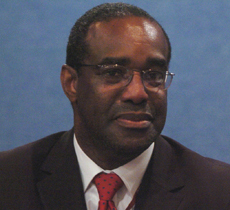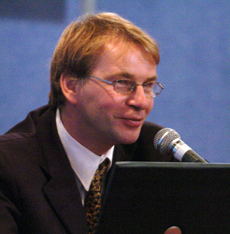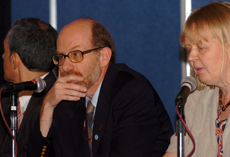|
Events convened on
Wednesday, 8 December 2004
|
|
Assistance by the GEF to address
capacity building and adaptation
Presented by the Global Environment
Facility (GEF)
|
|
|
|
 |
|
Mozaharul Alam, Ministry of Environment
and Forests of Bangladesh, said
Bangladesh’s NAPA will consider
synergies with multilateral
environmental agreements, resource
management and poverty alleviation. |
|
Mozaharul Alam, Ministry of
Environment and Forests of
Bangladesh, presented Bangladesh’s
National Adaptation Program for
Action (NAPA) process, noting its
multidisciplinary nature and
stakeholder participation. He said
the aim of the process is to
identify immediate and urgent
adaptation measures with
cross-sectoral benefits. He
explained the parameters and
indicators used in assessing
adaptation needs, and said
adaptation measures will be
prioritized on the basis of
indicators such as impact on
livelihoods, ecological
conservation, and implementation
costs. He highlighted the importance
of considering funding potentials
when selecting adaptation measures,
and said delaying implementation
would increase vulnerability and the
future cost of adaptation.
Liza Leclerc, UNEP, indicated that
Mauritania had completed its NAPA,
and mentioned workshops and support
that is being given to assist
countries in NAPA preparations.
Bonizella Biagini, GEF, noted that
the available GEF funding for
adaptation amounts to US$ 110
million distributed through three
funds, namely the Strategic Priority
in Climate Change (SPA) Fund, the
Least Developed
|
|
 |
|
Panelists considered the formulation of
national adaptation policies, stressing
the importance of early action and
stakeholder involvement. |
|
Country (LDC) Fund and the Special
Climate Change (SCC) Fund. She
emphasized that these funds are
complementary, and said co-financing
with other institutions is intended
to simplify the funding process.
Biagiani noted that the GEF’s
current adaptation portfolio
consists of four projects. She
explained the Operational Guidelines
for projects under the SPA Fund,
saying candidate projects should,
inter alia: be country-driven and
integrated into national policy;
achieve global environmental
benefits; and disseminate lessons
learnt. She also noted that the
first elements of the LDC Fund are
under development.
Carlos Costa Posada, Colombia’s
Institute of Hydrology, Meteorology
and Environmental Studies, presented
Colombia’s Integrated National
Adaptation Pilot (INAP), noting that
it concentrates on high-mountain
ecosystems, Caribbean insular areas
and human health. He said the INAP
|
|
|
builds
on risks identified in the first
National Communication, and aims
to incorporate the expected
impacts of climate change into
sectoral policies, formulate
specific programmes, and
implement adaptation measures.
He indicated that the INAP
includes a monitoring and
evaluation system.
Juan Carlos Romero, Ecuador’s
Ministry of the Environment,
presented his country’s National
Capacity Self-Assessment (NCSA)
process, which focuses on the
identification of capacity
constraints in addressing
climate change, biodiversity
loss and desertification. He
said the NCSA considered
sectoral, cross-sectoral and
specific frameworks, and
highlighted the role of
stakeholder consultations in the
process. He explained that the
outcomes include 12 Project Idea
Notes, concrete initiatives, and
an action plan that highlights
the need to strengthen the
Ministry of the Environment and
adopt innovative tools for
biodiversity conservation.
Discussion: Participants
highlighted the importance of
public participation in the NAPA
and NCSA processes, in
particular that of indigenous
populations, and considered ways
of organizing consultations at
the community level.
Participants also considered
cooperation between various
institutions, especially those
not normally involved in climate
change issues. Biagini
highlighted the need to maximize
cooperation between funding
institutions, saying more should
be done in this respect. |
|
US actions to address climate change
Presented by the US
|
|
|
 |
|
Ahsha Tribble, US Department of
Commerce, said science should inform
rather than dictate policy making, and
stressed that her Department’s
scientific programmes are open and
transparent. |
|
Ahsha Tribble, US
Department of
Commerce, introduced
the Strategic Plan
of the US Climate
Change Science
Programme,
emphasizing that the
aim of the programme
is to reduce
scientific
uncertainty relating
to climate change.
David Conover, US
Department of
Energy, noted the
ambitious research
and development
agenda of his
department’s Climate
Change Technology
Programme. He
stressed that the
programme aims to
ensure that a
diverse portfolio of
candidate
technologies compete
in the market place.
He noted that energy
efficiency
represents the
largest investment
area, and said tax
incentives are used
to promote energy
efficiency.
Noting that the
agricultural sector
both contributes to
GHG emissions and is
vulnerable to
climate change,
Bruce Knight, US
Department of
Agriculture,
stressed the need to
mitigate the impact
of climate change on
farmers and identify
their role in
reducing emissions.
Knight indicated
that, while the
costs of reducing
GHG emissions fall
on the agricultural
sector, the benefits
are public. He
stressed that
farmers should be
able to |
|
recover these costs, and
identified the need to value
and market emerging
benefits.
Larisa Dobriansky, US
Department of Energy,
introduced Climate Vision, a
voluntary programme
including 13 partner
associations that represent
90% of US industrial
emissions. She noted that
the programme aims to
examine climate technology
needs, evaluate possible
funding mechanisms, and
promote research and
development (R&D) and
technology diffusion.
Susan Wickwire, US
Environmental Protection
Agency (EPA), described the
EPA’s voluntary climate
change programmes, noting
that they seek to address
inefficiencies in the market
and provide information,
technical assistance, and
recognition for
environmental leadership.
Discussion: Noting the high
cost of the Climate Change
Science Programme, a
participant questioned
whether the US might not
rather have relied on
science emerging from the
IPCC and better spent the
money directly on mitigation
efforts. Harlan Watson, US
Department of State,
indicated that the IPCC’s
outputs do not represent the
final word. A participant
highlighted the fact that,
even if the US Presidential
Climate Change Strategy’s
target to reduce GHG
intensity by 18% by 2012 is
met, overall US GHG
emissions will increase by
14% from 2002-2012, to reach
GHG emission levels of 32%
above the 1990 baseline. A
participant highlighted
uncertainty among US
corporations concerning the
status of early action
credits and baselines for
action as a hurdle to their
involvement in voluntary
agreements.
|
|
|
BINGO anniversary event – 10 years of
business achievements
Presented by the International Chamber
of Commerce (ICC)
|
|
 |
|
Fiona Wain, Environment Business
Australia, said the amount of energy
that can be derived from a single
deep-hot rock site is equivalent to 5 to
6 times that of Australia’s natural gas
potential. |
|
Joke Waller-Hunter, UNFCCC Executive
Secretary, stressed that business is
part of the solution to climate
change, noting that industrial
emissions are declining. She said
the Kyoto Protocol’s entry into
force will create incentives for
investment in environmentally
friendly technologies.
Nick Campbell, ARKEMA, introduced
the ICC’s efforts to address climate
change through the measurement of
emissions and R&D of new
technologies.
Laurent Corbier, World Business
Council for Sustainable Development
(WBCSD), highlighted WBCSD’s
cooperation with the ICC.
James Wolf, US Business Council for
Sustainable Energy, noted the
Council’s efforts in introducing
clean energy technologies, and said
market access to new technologies
would enhance compliance with the
Kyoto Protocol.
In a panel on national
organizations, Adriana Kowalewski,
Argentina’s Association of Producers
of Electricity (AGEERA), highlighted
AGEERA’s
achievements in enhancing
thermoelectric power
generation, noting that
prices in Argentina are
among the world’s lowest.
|
|
Noting uncertainties
regarding the cost of
adaptation and stressing
that prevention is less
expensive than cure, Fiona
Wain, Environment Business
Australia, said abatement
and mitigation efforts
should be increased, and
discussed new technologies
such as deep-hot dry-rock
power generation, and water
desalinization fueled by
wave, tidal, solar and
geothermal power.
Yoshihiko Nagasato, Japan
Business Federation
(Keidanren), discussed
Keidanren’s voluntary action
plan to contribute to
reducing overall emissions
below 1990 levels by 2010.
John Scowcroft, Union of the
Electricity Industry,
reviewed European advances
in energy efficiency,
underscored the need for
systematic policy impact
assessments, and stressed
that unilateral advances on
clean energy can have
negative impacts on global
competitiveness.
In a panel on international
organizations, Emma Cornish,
World Nuclear Association,
said emissions-free nuclear
energy accounts for 16% of
the world’s energy
production, and has allowed
emissions reductions from
the European energy sector
by 56%.
Brian Flannery,
International Petroleum
Industry Environmental
Conservation Association (IPIECA),
said IPIECA contributes
experts to the IPCC, seeks
to improve operational
efficiency, participates in
commercial ventures on
renewable energy, and
organizes workshops and
symposia on climate change.
Kristen Sukalac,
International Fertilizer
Industry Association,
discussed emissions from
ammonia production and the
application of crop
nutrients, stressing that
energy consumption in
ammonia plants is steadily
declining.
Johanna Wickström, World LP
Gas Industry, detailed the
qualities and use of LP gas,
noting that it consists of
propane and butane,
generates low levels of GHG
emissions, and can be used
for transportation, cooking
and heating.
Jerry Marks, International
Aluminium Institute,
discussed voluntary
commitments to reduce GHG
emissions from the aluminum
industry. He noted that the
industry has achieved a 73%
reduction in global
emissions of
perfluorocarbons, and seeks
to be climate neutral by
2015.
|
|
Development and transfer of technology
Presented by the UNFCCC
|
|
 |
|
Frank Joshua, Climate Investment
Partnership, indicated that project
proposals require certain technical,
financial and risk components in order
to attract funding from private
investors, and said that project
developers in developing countries and
countries with economies in transition
lack the capacity to put together
bankable projects. |
|
Margaret Martin, Natural Resources
Canada, reported on a workshop on
innovative options for financing
technology transfer, held in
Montreal, Canada, from 27-29
September 2004. She stressed the
significance of risk in deterring
investment, and highlighted the need
to develop partnerships.
Daniele Violetti, UNFCCC, noted that
the private sector provides the
majority of resource flows to
developing countries for climate
change activities. In developing
project proposals, he stressed the
need to seek added value for
particular stakeholders, to quantify
expected benefits and revenues, and
to incorporate other priorities such
as poverty alleviation.
Yap Kok Seng, Malaysian
Meteorological Service, said that
Annex I Parties should create an
enabling environment to help reduce
the risk associated with investment
in technology transfer. He stressed
the need for additional finance
flows from outside the CDM framework
due to limitations associated with
CDM projects.
|
Thomas
Verheye, European Commission,
highlighted the role of small and
medium enterprises in driving market
innovation. He said it was not
necessary to design new financing
mechanisms, as existing ones can be
combined to provide new strategies.
He suggested that Patient Capital
could increase flows of capital to
local entrepreneurs and project
developers on an affordable basis.
He stressed that the roles of the
public and private sectors should be
clearly defined.
Frank
Joshua, Climate Investment
Partnership, said the low quality of
projects increases risk perception
among investors. He stressed that
project proposals should be
formulated so that private investors
are able to accurately assess the
risk and reward of investing in
projects. He stressed the need to
build tools and templates for risk
assessment and to integrate carbon
value into the financial components
of projects.
|
|
New Annex I GHG inventory reporting
software and related developments
Presented by the UNFCCC
|
|
 |
|
Vincent Lalieu, UNFCCC, explained the
data import and export features of the
new GHG inventory reporting software
“CRF Reporter.” |
|
Halldor Thorgeirsson, UNFCCC, said
the importance of reporting has
increased with the forthcoming entry
into force of the Kyoto Protocol,
noting that inventory reporting is
the backbone of climate policy.
James Grabert, UNFCCC, noted that
the “Common Reporting Format (CRF)
Reporter,” a GHG inventory reporting
software, has been developed to
facilitate GHG reporting on the
basis of a COP-8 decision. He said
the software has been delivered to
National Focal Points and
institutions responsible for
inventories.
Tleussen Temertekov, UNFCCC,
presented an overview of the
Secretariat’s software tools and
databases, describing challenges
faced during the development of the
CRF Reporter, including complexity
and amount of data, sectoral
differences, and differing data
formats. He outlined plans for
developing the software, including:
development of a module on land use,
land-use change and forestry (LULUCF);
elaboration of a simplified
web-based version for data import;
enhancement of existing databases;
and tools for further automation and
data quality improvement.
|
|
Vincent Lalieu, UNFCCC, explained
the history of the software’s
development, including inventory
compilations and testing by Parties,
and provided a demonstration of the
software. He highlighted import and
export features, consistency,
completeness and recalculation
checks, calculation options and
submission preparations.
Roberto Acosta, UNFCCC, asked
Parties to test the tool and to
report problems and recommendations
to the Secretariat.
Discussion: Several participants
expressed satisfaction with the
software, and recommended developing
more automation for data handling. |
|
2006 Intergovernmental Panel on Climate
Change (IPCC) Guidelines for National
Greenhouse Gas Inventories
Presented by the World Meteorological
Organization/UNEP IPCC
|
|
 |
|
Regarding the IPCC Guidelines due in
2006, panelists indicated areas where
changes or additions are anticipated. |
|
Simon Eggleston, IPCC, highlighted
the importance of the IPCC
Guidelines in furthering the goals
of the UNFCCC, and said the 2006
IPCC Guidelines consist of five
volumes: cross-cutting issues and
reporting tables; energy; industrial
processes and product use;
agriculture, forestry and other land
use; and waste. He also discussed
direct and indirect carbon dioxide
emissions and how they will be dealt
with in the 2006 Guidelines.
William Kojo Agyemang-Bonsu, IPCC,
introduced key issues in the volume
on industrial processes and product
use. He listed the GHGs and emission
sources included in the current
Guidelines, and discussed the
criteria for including new GHGs and
sources.
N.H. Ravindranath, IPCC, presented
the volume on agriculture, forests |
|
and other land use, noting that a
lot of experience has been
accumulated from the 1996 IPCC
Guidelines. He said the new
Guidelines will address problems
identified, such as the
classification of land categories,
and aim to be more user friendly.
Riitta Pipatti, IPCC, outlined the
volume on waste, focusing on main
changes and improvements. She listed
variations in waste treatment,
within and between countries, and
changes in waste management as
challenges.
Kenneth Skog, IPCC, discussed the
proposed guidelines for harvested
wood products. He defined harvested
wood products as any wood material
removed from the land. He said the
Good Practice Guidance Goals
influence the new Guidelines, noted
that the new Guidelines aim to be
“approach neutral,” and explained
how the estimations of carbon
storage will be done.
Dario Gomez, IPCC, introduced the
contents of the energy volume,
describing the evolution from the
1996 Guidelines, with a particular
focus on the reference approach. |
|
Synergies and tradeoffs between air
pollution control and GHG mitigation
Presented by the International Institute
for Applied System Analysis (IIASA)
|
|
 |
|
Frank Raes, Joint Research Institute,
reveals research suggesting that ozone
precursor emissions control could have
adverse effect on radiative forcing. |
|
Marcus Amann, IIASA, discussed the
use of models to analyze global
long-term stabilization strategies.
He emphasized that a sustainable
development scenario would help
achieving stabilization of GHG
emissions with minimal mitigation
measures, relying only on technology
transfer, research and development,
and population control.
Fabian Wagner, IIASA, presented on
the medium-term potential and cost
of national mitigation options. He
gave an overview of the GAINS model
developed by IIASA to assess
abatement costs of reducing
emissions of the six Kyoto gases,
and which has been applied to 43
regions in Europe.
Ger Klassen, European Commission,
spoke on assessing the
cost-effectiveness of medium-term
multi-gas mitigation strategies. He
reported projected reductions in
Europe of 1% for carbon dioxide, 19%
for methane, and 20% for nitrogen
oxide by 2012 relative to 1990. He
stressed that a 15% reduction of
carbon dioxide emissions in Europe
can |
|
be achieved by 2020 at a cost of €30
billion per year, amounting to 0.2%
of the gross domestic product.
Marcus Amann discussed co-benefits
of climate change mitigation on air
pollution. He stated that achieving
a 15% reduction in carbon dioxide
emissions in Europe by 2020 would
entail simultaneous reductions of
sulphur dioxide, nitrogen oxide and
particular matter, and imply 3000
fewer premature deaths. Amann noted
that such benefits would be even
greater in developing countries, and
would imply considerable cost
savings in health care and air
pollution control.
Frank Raes, Joint Research Centre of
the European Commission, made a
presentation on the impacts of ozone
precursor emissions on radiative
forcing and background ozone. He
said air pollution policy could have
negative effects on GHG emissions,
as nitrogen oxide controls decrease
ozone concentration but increase the
lifetime of methane. |
|
|
|







